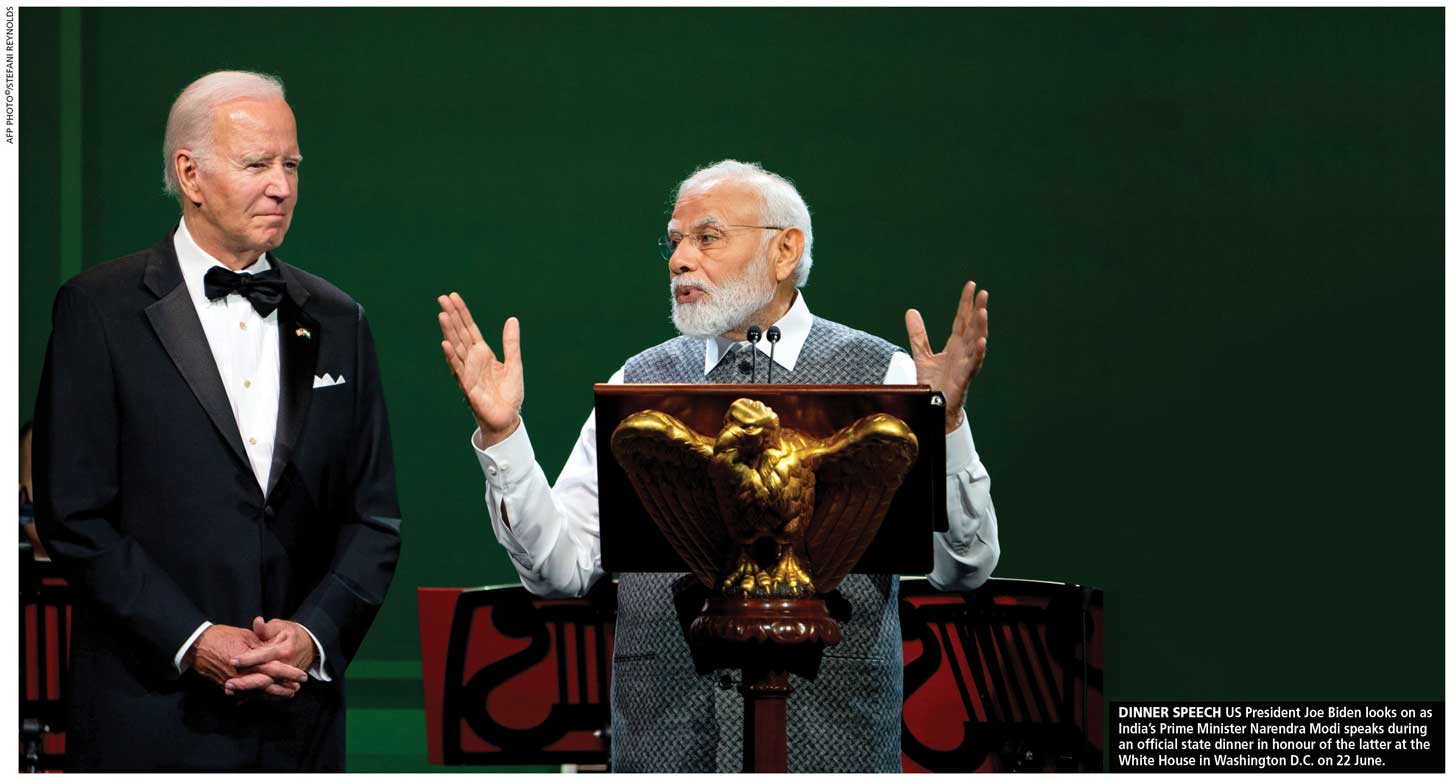INDO-US RELATIONS
FROM FOE TO FRIEND: PRIME MINISTER MODI
Saro Thiruppathy underscores Uncle Sam’s relationship with Indian Prime Minister Narendra Modi and how it has evolved for the better since 2005
In 2005, the Chief Minister of Gujarat Narendra Modi was banned from entering the US even though he possessed a tourist visa. The United States claimed that it was because he had failed to stop the anti-Muslim riots in his state – the Americans based their decision on a little-known law on religious freedom.
ELECTION VICTORY Nine years later in 2014, Modi’s Bharatiya Janata Party (BJP) won the general elections in India and he became the prime minister of the world’s largest democracy.
Soon afterwards, the US lifted the ban and said he was eligible for an A-1 visa. What’s more, then US president Barack Obama invited Prime Minister Modi to visit Washington.
Subsequently in September 2014, Modi visited the US and met with Obama in the White House. Even though a dinner reception was organised for him, he did not eat anything, saying he was observing a nine-day religious fast but courteously asked his host to go ahead and dine while he sat sipping warm water.
Before meeting Obama however, he attended the Global Citizen Festival in Central Park in New York City where thousands of people were enthralled by his words and presence. This was the beginning of Modi becoming a star attraction overseas; and the first step in garnering recognition and respect in the international arena.
THE RED CARPET Since then, he has met with several foreign leaders and many have rolled out the red carpet for him. When Modi visited Australia in May, he was accorded a ceremonial guard of honour upon arrival at Admiralty House.
The Prime Minister of Australia Anthony Albanese was impressed with Modi and likened him to a rock star. He said that even when Bruce Springsteen performed on that stage, he hadn’t garnered the welcome that the Indian PM received.
And to thunderous applause, Albanese added: “You have brought the spirit of the world’s biggest democracy to Australia… Prime Minister Modi is the boss.”
Modi has also shown that he’s a good friend to his contemporaries in the region – particularly Moscow – and has refused to be swayed by NATO’s demand that India stops trading with Russia in line with sanctions.
He’s upheld India’s foreign policy of nonalignment and this message has been strongly conveyed to the West.
Though he has visited the US several times since the travel ban was lifted, his maiden state visit to Washington took place from 20 to 24 June. Modi is also the only Indian leader to address the US Congress twice.
Previous state visits by Indian leaders included one by former president S. Radhakrishnan in June 1963 and several years later, by former prime minister Dr. Manmohan Singh. Visits by other Indian leaders have been simply classified as ‘official visits.’
NOTABLE OUTCOMES In addition to the two countries strengthening their defence and strategic partnership as a result of the recent visit, there have been other significant wins in the spheres of technology and aeronautics.
General Electric (GE) signed an MOU with Hindustan Aeronautics to produce fighter jet engines for the Indian Air Force. India can manufacture the fighter jets but not the engines to power them. This is quite a win for Modi since the US is generally not willing to share its military technology with other countries.
If Washington’s enthusiasm was to ensure that India would be a warring ally against Beijing, it’s possible that the US may end up being very disappointed
India will also purchase armed MQ-9B SeaGuardian drones and this too is quite a feat since only a few United States allies own Predator drones.
Meanwhile, the US has promised to help the subcontinent increase production of electric vehicles, and meet its goal of installing 500 gigawatts of wind, solar and other renewable energy projects over the next few years. India’s Vikram Solar will invest about US$ 1.5 billion in the American solar energy supply chain.
And US memory chip company Micron Technology has committed to investing 825 million dollars to set up a chip assembly and test facility in Gujarat.
India will join the United States led Artemis Accords in space exploration and work with NASA on a joint mission to the International Space Station (ISS) next year.
The retaliatory tariffs imposed by India on some US food will be lifted even if American tariffs on steel and aluminium imports remain.
THE BEIJING FACTOR While all this pomp and pageantry was taking place, China was certainly present in spirit. However, if Washington’s enthusiasm was to ensure that India would be a warring ally against Beijing, it’s possible that the US may end up being very disappointed.
The Indo-China reality was best summed up by Tata Chair for Strategic Affairs and Senior Fellow at the Carnegie Endowment for International Peace Ashley Tellis: “India values cooperation with Washington for the tangible benefits it brings but does not believe that it must in turn materially support the US in any crisis – even one involving a common threat such as China.”





